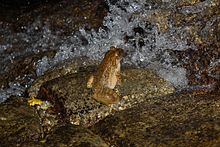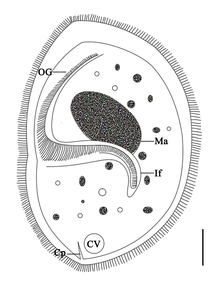|
棘胸蛙
棘胸蛙(學名:Quasipaa spinosa),又名石蛤、石鸡、山鸡、石冻、飞鱼、石鳞、石蛙、石蛤蟆、石虾蟆、石坑蛙等,是两栖纲无尾目叉舌蛙科的一种动物。其肉可食用[2]。本物種的中文名稱及學名均源於其雄蛙胸前的大型胸棘[3][4]。其體型在蛙類來說算是大型,因為已知可長至超過10 cm(4英寸),使牠們贏得香港體型最大蛙類的美譽[3][5]。 分類學近年的分子系统发生学分析認為本物種事實上由三條不同的譜系組成。因此,名義上的Quasipaa spinosa可能代表一個隱藏物種複合體。谱系在地理上是不同的;在云南省找到一个谱系, 中国东南部(安徽省、 浙江省、福建省北部和江西省)还有一个谱系, 第三个谱系位于中国中南部(南部福建省、江西省、湖南省、广东省和广西壮族自治区)。在该分析中,小棘蛙位于Quasipaa spinosa内。[6]。它的复合种是越南的Quasipaa acanthophora[7]。 The complete 线粒体DNA (18,012 base pairs in length) of Quasipaa spinosa has been sequenced, helping to shed light into the 系統發生樹 of Quasipaa and related frogs.[8] 分佈、棲息地及習性本物種棲息於中华人民共和国长江以南(包括香港)地域的山溪水坑内或石洞岩隙中。由於水體相通,估計亦同時分佈於越南、老挝及缅甸三國的淡水水域,但缺乏相關文獻報告的支持。 习性昼伏夜出,主要食物为昆虫及其幼体。每年11月-翌年4月冬眠。 No certain records exist from Vietnam, earlier records may refer to Quasipaa acanthophora described in 2009 as a new species from that country.[2] It may also have been mixed with 多疣棘蛙 and 双团棘胸蛙.[1] Quasipaa spinosa is associated with rocky streams in evergreen forests and open countryside on hills and mountains. Its altitude range is about 200—1,500米(660—4,920英尺) above sea level.[1] 形態特徵及生命週期成年个体体长8-20cm,体重200-350g。背面黑灰色、浅棕色或黄褐色。背面、侧面和四肢皮肤上生有肉疣,有的时候疣上生黑色角质刺。 The most distinctive characteristic of Quasipaa spinosa are the keratinized skin spines in the chest of males.[4][9] It is dark brown in colour, interspersed with dense, yellowish mottling.[3] Quasipaa spinosa are moderately large frogs: males grow to a snout–vent length of about 80 mm(3.1英寸) and females to 82 mm(3.2英寸)[10] or more, up to 128 mm(5.0英寸) in snout–vent length.[3][11] It is the largest frog in 香港.[3][5] Later studies has shown that usually males are larger than females, but with considerable overlap between sexes. Body size is positively correlated with maximum temperature and rainfall. Mean body weight among males may reach at least 133 g(4.7 oz).[4] Quasipaa spinosa breeds in streams, laying the eggs in water under stones.[1] Reproduction takes place in April–October. Male frogs call near slow-flowing sections of streams or around pools adjacent to streams. The advertisement call consists of three to seven notes, the last being the longest. Pairs in amplexus are found within the chorus area.[12] Population demography of Quasipaa spinosa has been studied for two populations in the 大帽山 in Hong Kong. These populations exhibit high site fidelity. Populations have low densities (13–42 frogs per 100 m of stream) and female-biased sex ratio. Each female produced an average 1.26 juveniles that survived until the age of 2 years. Annual survival was low, 38–65%.[13]  用途因为肉味鲜美,生长速度快而且个大,是主要的食用蛙类之一。 Quasipaa spinosa is an important food and medicinal resource in China and considered as a delicacy.[13] Populations are heavily harvested, and overcollection is implicated in population declines.[13] In 江西省 province alone, the value of production of Quasipaa spinosa for domestic consumption is of the same magnitude as global trade of frog meat. Quasipaa spinosa are also farmed, but farming operations are likely based on tadpoles or juveniles sourced from wild population, instead of captive breeding. Thus, farming may not reduce the pressure on wild populations.[13] 保育過往本物種的數量曾經有大量,但由於遭到大量捕殺,目前已被國際自然保護聯盟列為易危物種,因為在最近期的三代,其數量已下跌了超過三成。捕殺主要還是被捕獲與人類食用;其次是因為農業及水壩的興建導致的棲息地破壞[1]。當物種的數量變得愈來愈少,即使是中等數量的下跌亦已足以令物種的滅絕風險提過[13]。在中國,棘胸蛙是江西省和安徽省的重点保护野生动物之一。另外自20世纪80年代起,棘胸蛙也被广泛养殖用作食品,以避免野外再有人去捕捉棘胸蛙作食用[14]。 棘胸蛙在中国已被列为国家二级保护野生动物。 寄生蟲 棘胸蛙體內的寄生蟲均為纖毛蟲,計有多粒韦氏肠肾虫(Sicuophora multigranularis[15],舊作Wichtermania multigranularis Xiao et al., 2002[16])。Wichtherman 根据 Cheng 在福建採集的棘腹蛙体内的标本, 发现棘蛙韦氏肠肾虫(Wichtermania (Nyctotherus) cheni)[16]。 參考文獻
|
||||||||||||||||||||||||||||||||||||

